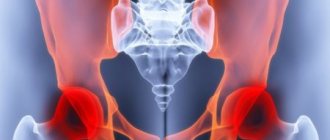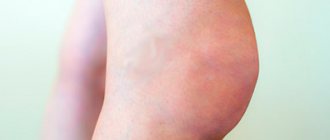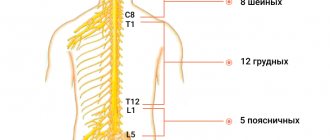Myofascial pain syndrome (MPPS) is a common clinical problem of muscle pain, including sensory, motor and autonomic symptoms caused by the occurrence of myofascial trigger points (MFTP). Despite the fact that MFPS is quite common in clinical practice, there are few studies on the prevalence of this disease. Skootsky et al. found that 30% of patients attending a primary care department were found to have MPTTs. In a recent study regarding shoulder pain, Bron et al. It was concluded that all 72 patients included in the study had MPTTs in the shoulder girdle muscles, predominantly in the infraspinatus and upper trapezius muscles.
A myofascial trigger point is described as a hyperirritable point, usually located within an area of skeletal muscle tension, that causes pain upon compression and can be a source of referred pain, motor dysfunction, and autonomic phenomena.
Classification and clinical picture
MPTTs are classified as active and latent trigger points. An active trigger point is a point with spontaneous pain or pain in response to movement that can provoke local or referred pain. A latent trigger point is a sensitive point with pain or discomfort that appears only in response to compression.
Active or latent MPTTs are subject to the following clinical characteristics.
- Pain with compression. Compression may cause local pain and/or referred pain, similar to the patient's typical complaints, or may worsen existing pain.
- Local reaction in the form of twitching. Palpation with crunching (rapid compression through muscle fibers) can cause a local twitching reaction, which is manifested by rapid contraction of muscle fibers in or around the site of tension.
- Muscle tension. Limited range of stretch and increased sensitivity to stretch at the site of tension can lead to tightness in the muscles involved.
- Local myasthenia. The muscle with the trigger point may be weak, but usually there is no atrophy.
- Patients with trigger points may have associated local autonomic phenomena, including vasoconstriction, pilomotor response, and hypersecretion.
Prevention
Preventive measures require compliance with several rules:
- avoid hypothermia;
- avoid stress if possible;
- do not overwork;
- do warm-ups during sedentary work;
- adhere to a nutritious diet;
- exercise;
- maintain correct posture;
- wear comfortable clothes;
- organize a comfortable and healthy sleep.
Make an appointment through the application or by calling +7 +7 We work every day:
- Monday—Friday: 8.00—20.00
- Saturday: 8.00–18.00
- Sunday is a day off
The nearest metro and MCC stations to the clinic:
- Highway of Enthusiasts or Perovo
- Partisan
- Enthusiast Highway
Driving directions
Etiology
Several possible mechanisms can lead to the development of MPTT, including low-level muscle contractions, muscle contractures, direct trauma, muscle overload, postural tension, unusual eccentric contractions, eccentric contractions in uncontrolled muscles, and maximal or submaximal concentric contractions.
Low level muscle contractions
Low-level muscle contractions are associated with selective overload of the earliest recruited and last derecruited motor units (“Henneman size principle”). Small motor units turn on before and turn off after large ones. As a result, smaller type I fibers are continuously activated during prolonged performance of motor tasks, which in turn can lead to metabolic overload of motor units with subsequent activation of autogenic destructive processes and muscle pain, which is also known as the “Cinderella hypothesis.”
Muscle contractures
Long-term contractures can lead to the formation of areas of tension within the muscle fibers. The tension zone is the first sign of a muscle response to biomechanical stress. This may be accompanied by the formation of hidden trigger points, which may eventually develop into active trigger points.
Direct trauma
Direct trauma can create a vicious cycle of events in which damage to the sarcoplasmic reticulum or muscle cell membrane can lead to an increase in calcium concentration, subsequent activation of actin and myosin, a relative lack of adenosine triphosphate (ATP) and disruption of the calcium pump, which in turn will increase intracellular concentration calcium even more, completing the cycle. As a result, areas of tension may develop within the muscles, leading to the formation of active or latent MPTTs.
Maximal or submaximal concentric contractions
During maximal or submaximal concentric contractions, large amounts of energy (ATP) are required. When exercise demands begin to exceed the ability of muscle cells to produce ATP, anaerobic glycolysis begins to consume more and more of the available intracellular ATP. The muscle will eventually run out of ATP and sustained muscle contractions may occur, triggering the development of trigger points.
Check out the article: Exercises to Manage Pain.
Autonomic dysfunction
All processes that support both the life of the organism and its work are called vegetative. This includes breathing, nutrition and excretion, sleep and wakefulness, heating the body in the cold and cooling in the heat, and much more. Any disruption of these processes is usually called autonomic dysfunction.
In simple cases of myofascial syndrome, autonomic dysfunction is subtle. It is manifested by swelling of the sore spot, change in skin color or impaired sweating. But when myofascial syndrome is expressed strongly or for a long time, then autonomic dysfunction acquires very striking features. Morning stiffness, dizziness, nausea, sometimes vomiting, stuffy ears, a lump in the throat and anxiety appear. General weakness, fatigue, irritability, depression, bad mood and tearfulness, insomnia at night and drowsiness during the day, absent-mindedness and memory loss occur. Disturbances in the functioning of internal organs are common: abdominal pain, palpitations, lack of air. Headaches, feeling of squeezing of the head, torso or limbs.
However, patients associate all of the listed autonomic disorders with anything, but not with muscles. Therefore, people turn to a chiropractor as a last resort, thereby allowing the disease to spread its influence.
Pathophysiology
The initial muscle changes associated with myofascial pain seem to lead to the further development of a tension zone, which in turn is a movement abnormality. Several mechanisms have been put forward to explain this motor abnormality, the most accepted of which is the "Integrated Hypothesis", first developed by Simmons and later expanded by Gerwin.
Simmons' integrated hypothesis is a six-link chain that begins with abnormal release of acetylcholine. This causes an increase in muscle fiber tension (formation of a tension zone). The tension zone is thought to reduce blood flow, leading to local hypoxia. Decreased oxygen levels disrupt mitochondrial energy metabolism, reducing ATP, and leading to tissue distress and the release of sensitizing substances. These sensitizing substances lead to pain when nociceptors are activated and also lead to autonomic modulation, which then enhances the first step: abnormal acetylcholine release.
You can read about pain mechanisms here.
Gerwin expanded on this hypothesis by adding more specific details. He stated that the activity of the sympathetic nervous system increases the release of acetylcholine and that local hypoperfusion caused by muscle contraction (tight rim) leads to muscle ischemia or hypoxia, which in turn leads to a decrease in pH ("acidification" of the environment).
Prolonged ischemia also leads to muscle damage, which promotes the release of potassium, bradykinins, cytokines, ATP, and substance P, which can stimulate nociceptors in the muscles. The end result is the tenderness and pain seen in MPTT.
Depolarization of nociceptive neurons causes the release of calcitonin gene-related peptide (CGRP).
CGRP inhibits acetylcholinesterase, increases acetylcholine receptor sensitivity and acetylcholine release, leading to SEA.
In recent studies, Shah et al. confirmed the presence of these substances using microdialysis methods at trigger points. Increased levels of substance P, protons (H+), CGRP, bradykinin, serotonin, norepinephrine, TNF (tumor necrosis factor), interleukins and cytokines have been found in active trigger points compared to normal muscle or even latent trigger points. The pH of the active trigger point region decreased to 4 (normal value is 7.4), causing muscle pain and soreness, as well as decreased acetylcholinesterase activity, which led to prolonged muscle contractions.
Chronicity factors
In some cases, there may be “chronization factors” that have a direct effect on myofascial pain. These factors can chronicize pain and tenderness, playing an important role in the widespread distribution of pathological symptoms through central sensitizing mechanisms.
Mechanical factors
- Scoliosis.
- Difference in leg length.
- Hypermobility of joints.
- Excessive use of muscles.
Systemic or metabolic factors
- Hypothyroidism.
- Iron deficiency.
- Vitamin D deficiency.
- Vitamin C deficiency.
- Vitamin B12 deficiency.
Psychosocial factors
- Stress.
- Anxiety.
Other factors of chronicity
- Infectious diseases.
- Parasitic diseases (eg Lyme disease).
- Polymyalgia rheumatica.
- Use of drugs from the statin class.
In some cases, correction of the identified chronicity factor can lead to complete elimination of pain and may be the only therapeutic approach needed to relieve the patient's symptoms.
Why does pain occur?
There are a number of circumstances due to which spasm appears and muscle tissue becomes tense:
- osteochondrosis;
- inflammation in the joints;
- diseases of the heart, kidneys, liver, ovaries;
- short neck and narrow shoulders (constant muscle tension);
- congenital anomalies of the spine;
- muscle immobilization due to sedentary work;
- uncomfortable posture during deep sleep;
- microtrauma of untrained muscles;
- musculoskeletal injuries;
- disruption of muscle structure due to bruise;
- stress and depression;
- hypothermia.
Diagnostics
Palpation is the gold standard in determining the presence of an area of muscle tension. This involves training and developing the precise skills of specialists to identify these stress areas.
Palpation of tension areas requires precise knowledge of muscle anatomy, the direction of specific muscle fibers, and muscle function.
Muscle palpation must meet several basic criteria and supporting observations to identify the presence of trigger points.
Main criteria
- Tension zone (where muscles are accessible).
- Presence of a place of pain in the tension zone.
- Reproduction of symptoms upon palpation.
- Pain occurs when a muscle is stretched (limited range of motion).
Supporting Observations
- Visual or tactile response to local twitching.
- The patient reports pain when pressing in the tension area.
- SEA was confirmed by electromyography.
Over the past few years, the reliability of palpation has been the subject of scientific debate. Recent studies have seen improvements in methodological quality, but the main problem is the lack of blinding. This is a problem that is difficult to solve because the reliability of palpation depends on the level of competence of the specialist.
Recent studies have shown interesting results using magnetic resonance elastography. The technique involves injecting cyclic waves into the muscle and then using phase contrast imaging to identify tissue distortions. Wave speed is determined from graphic images. Shear waves travel faster in stiffer tissues. And then the tension zone can be distinguished from the surrounding normal muscles.
Another recent method used to confirm dilatation of MPTT areas is sonoelastography combined with Doppler imaging.
It uses a clinical ultrasound imaging system with a linear resolution of 12-5 MHz coupled to an external vibration source (handheld vibration massager) operating in cycles of approximately 92 Hz. Doppler imaging is used to identify surrounding blood flows.
Ballyns et al showed that sonoelastography can be a useful tool for classifying MPTT into regions. Larger areas correspond to active trigger points, and smaller areas correspond to latent trigger points.
It is noted that this method requires preliminary manual palpation of trigger points.
Differential diagnosis
One source of confusion surrounding myofascial pain is fibromyalgia. It is true that both entities can cause severe muscle pain and soreness, but they have different etiologies or pathogenesis and their clinical presentation is not the same. Therefore, two different conditions must be distinguished.
In 1990, the American College of Rheumatology published diagnostic and classification criteria for fibromyalgia. This classification was updated in 2010. Diagnosis of fibromyalgia is based on a history of widespread pain (for at least 3 months), defined as bilateral pain, pain in the upper and lower body, and the spine, and the presence of excessive tenderness when applying pressure to 11 of 18 specific musculotendinous sites or painful points.
Key Differences Between Myofascial Pain and Fibromyalgia
| Myofascial pain | Fibromyalgia |
| Local pain | Widespread pain |
| Regionality | Bilateral as well as “axial pain” |
| Presence of tension zone | No tension zone |
| Referred pain | Presence of at least 11 painful points |
The differential diagnosis should be weighed against other conditions such as muscle spasm, neuropathic or radicular pain, delayed onset muscle pain, joint dysfunction, and infectious myositis.
Muscle imbalance. Chronic muscle overload is the main danger
What is muscle imbalance? The balance between which muscles is disturbed with it? There is an opinion that muscle imbalance is a violation between the so-called opposing antagonist muscles, that is, flexor and extensor, anterior and posterior, deep and superficial. But in reality, muscle imbalance is an imbalance between the phasic and tonic muscles.
According to their functions, the muscles of our body are divided into two groups. Some perform a movement and are called motor, dynamic, or phasic. Others hold the pose, counteracting the gravitational forces of the earth's attraction and the pressure of the atmosphere on us. These muscles are called postural-tonic, tonic, or postural. During movement, all muscle groups work. For example, when walking, the motor muscles “go”, and the postural-tonic muscles keep the body vertical. Therefore, the workload of both groups is distributed evenly and balanced. When a person is motionless, for example, sitting, then only his tonic muscles work, and his motor muscles are inactive.
The life of a modern person is deprived of movement. Today, since childhood, static and monotonous poses have prevailed. And if we add to this poor posture and scoliosis, which in themselves are a static overload, then the scale of the problem becomes obvious. Static monotony forms a fatigue overstrain of the tonic muscles, which causes them to shrink and become “woody,” while the motor muscles, on the contrary, become decrepit from prolonged inactivity.
It is this ratio, when the tonic muscles are overloaded with work, and the motor muscles are relaxed from idleness, that is usually called muscle imbalance.
Sooner or later, muscle imbalance leads to the appearance of local muscle spasms. Having begun due to chronic muscle overload, spasms intensify under the influence of “second-order” causes. What aggravates the problem is that a person cannot feel muscle imbalance, unlike injury, heaviness or hypothermia. The invisibility of the initial stage of the disease allows it to take deep roots and spread its sprouts everywhere.
Treatment
There are two different approaches to treating MPTT: noninvasive methods such as ultrasound therapy, low-level laser therapy, transcutaneous electrical nerve stimulation (TENS), drug therapy (such as muscle relaxants), and several physical and manual therapy modalities.
These include:
- Stretching techniques.
- Muscle-energy techniques.
- Postisometric relaxation.
- Myofascial release.
- Compression of trigger points.
- Massage.
Friends, this and other questions will be discussed in detail at Dmitry Gorkovsky’s seminar “Myofascial release (a scientific approach to increasing joint mobility).” Find out more...
In a recent study, Bron et al. conducted a controlled study in the treatment of MPTT in patients with shoulder pain. They decided to use only manual techniques associated with home exercises and ergonomic recommendations. After 12 weeks of treatment, the test group showed a statistically significant improvement compared to the control group.
On the other hand, there are various invasive techniques that have a common goal: inactivation of active loci at a central trigger point by needle insertion.
There are different ways:
- Dry needle.
- Anesthetic injections.
- Injection of botulinum toxin A.
SWT for myofascial syndrome of the lumbosacral region: review of scientific literature
S.P. Mironov and co-authors studied the effect of shock wave therapy on the effectiveness of treatment of patients with myofascial syndrome of the lumbosacral region of various natures [7]. The study involved 375 patients - athletes and ballet dancers. The patients were divided into three groups:
- Group with primary myofascial syndrome.
- Group with primary spondyloarthrosis complicated by myofascial syndrome.
- Group with primary spinal osteochondrosis complicated by myofascial syndrome.
All patients received monotherapy with shock waves using the Richard Wolf Piezowave device, without medications or other physical treatment. There are 5 procedures per course, 1 per week. During the first procedure, diagnostics were carried out - a search for a trigger point. The patients felt tolerable pain. Already by the second session the pain was significantly reduced, and by the third it was relieved almost completely.
After treatment, the average pain score on the VAS scale during movements decreased from 8 to 3 in groups 1 and 2, and from 8 to 4 in group 3. After 3 months, this score decreased to 0 in patients with isolated myofascial syndrome, and did not increase by over 1 year of observation.
In group 2, after 3 months the pain decreased to 1.5 points, and a year later it increased to 2.5 points.
In group 3 (suffering from osteochondrosis), the pain began to return and after a year reached a value of 6 points.
Based on their study, the authors concluded that shockwave therapy is more effective in cases of primary myofascial syndrome and less effective in the case of degenerative spinal diseases.











